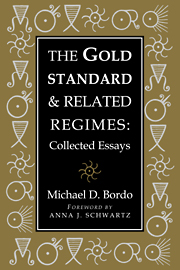Book contents
- Frontmatter
- Contents
- Foreword
- 1 The Gold Standard and Related Regimes: Introduction to the Collection
- Part I History of Doctrine and the Gold Standard
- Part II The Gold Standard as a Commodity Standard
- Part III The Gold Standard as a Contingent Rule
- Part IV Historical Case Studies
- 10 A Tale of Two Currencies: British and French Finances During the Napoleonic Wars
- 11 Money, Deflation, and Seigniorage in the Fifteenth Century: A Review Essay
- Part V The Bretton Woods International Monetary System
- Index
- Titles in the series
11 - Money, Deflation, and Seigniorage in the Fifteenth Century: A Review Essay
Published online by Cambridge University Press: 19 October 2009
- Frontmatter
- Contents
- Foreword
- 1 The Gold Standard and Related Regimes: Introduction to the Collection
- Part I History of Doctrine and the Gold Standard
- Part II The Gold Standard as a Commodity Standard
- Part III The Gold Standard as a Contingent Rule
- Part IV Historical Case Studies
- 10 A Tale of Two Currencies: British and French Finances During the Napoleonic Wars
- 11 Money, Deflation, and Seigniorage in the Fifteenth Century: A Review Essay
- Part V The Bretton Woods International Monetary System
- Index
- Titles in the series
Summary
Introduction
Monetary economists have long been interested in economic history as a laboratory for the testing of theory. For the monetary economist, unusual monetary disturbances such as gold discoveries and hyperinflations, unique institutional arrangements such as free banking, and unique monetary standards such as bimetallism provide the raw materials for the testing of theories.
Monetary economics has focused mainly on the experience of Western Europe and North America since the beginning of the nineteenth century, because of the availability of data and of continuity to modern times of institutions then established. However, there has also been considerable interest in episodes from the preceding three centuries, e.g., the Price Revolution of the sixteenth century [Hamilton (1934)], Colonial money issues [Smith (1985), Wicker (1985)], the assignat hyperinflation [White (1985)], the historical sources of hyperinflation [Capie (1986)], and the South Sea Bubble [Neal and Schubert (1985)].
One largely overlooked episode of history of great potential interest to the monetary economist is the late Middle Ages in Northwestern Europe. Topics of interest for recent theory from this episode include: conflicting monetary and real explanations for long-run price level and real output movements, the operation of early commodity money standards, early attempts at inflationary finance, time-inconsistent monetary policies, and the issue of credibility.
I first present an overview of the key themes in late medieval monetary history highlighting the debate between realists and monetarists. I then examine the issue of politics and money, focusing on debasement as a policy tool, following which I assess an excellent recent contribution to this literature, H. Miskimin's Money and Power in Fifteenth Century France (1984).
- Type
- Chapter
- Information
- The Gold Standard and Related RegimesCollected Essays, pp. 382 - 392Publisher: Cambridge University PressPrint publication year: 1999



